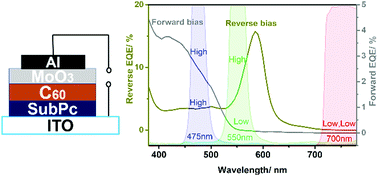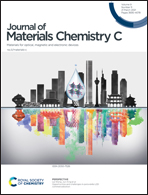Trilayer organic narrowband photodetector with electrically-switchable spectral range and color sensing ability†
Abstract
Conventional photodetectors are usually “color blind” and require additional dispersive components or complicated structures to recognize colors. In this work, an organic photodetector (OPD) is designed with a layer of molybdenum(VI) oxide (MoO3) stacked on an organic donor/acceptor charge transfer interface. The band structure of the OPD is designed with multiple charge separation channels that can be activated/deactivated under reverse and forward biases. The combination of a high or low photocurrent under reverse and forward biases determines the colors of the received light, and that forms the heart of “non-color blind” ability to recognize light colors in the OPD. The energy structure and charge collection pathways in the OPD are investigated with biased external quantum efficiency (EQE), ultraviolet photoelectron spectroscopy (UPS) and current density–voltage (J–V) studies. The OPD with the ability of color and wavelength determination demonstrates its potential to recognize colors without using additional components and the dual mode operation enables it to work under different conditions via switching its detection ranges with bias voltages. This design principle can be utilized to fabricate multifunctional devices by simply selecting different donor–acceptor materials according to the desired detection ranges.



 Please wait while we load your content...
Please wait while we load your content...